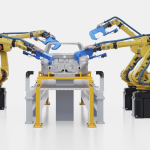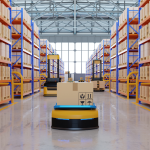A new survey of supply chain executives from Deposco, reveals a widening gap between AI investment and measurable returns. While AI is embedded in high-value areas such as logistics and demand forecasting, 47% of organizations report difficulty quantifying its impact. The challenge isn’t deployment but integration—moving AI from a collection of automation tools to a fully orchestrated, enterprise-wide capability. As AI spending accelerates, the companies seeing the strongest returns are those shifting from process-specific applications to a unified intelligence framework.
Survey Insights: AI Investment vs. Measured Returns
Supply chain leaders are advancing beyond pilot programs, with 46% of companies now actively using AI. Yet, despite substantial investment, nearly half struggle to measure return on investment. The issue is not AI’s potential but its fragmented application.
Most AI initiatives are still in the early stages, with 42% of organizations having deployed AI for less than two years. That limited maturity is restricting its effectiveness. AI is proving its value in logistics, demand forecasting, and inventory optimization, but many businesses still operate it in isolation—automating functions rather than decisions.
A key constraint is data integration. While AI thrives on structured, real-time intelligence, 78% of supply chain leaders still manage inventory, logistics, and procurement data in separate systems. That lack of connectivity prevents AI from generating network-wide impact, keeping benefits locked within specific operational silos.
According to Jason Franklin, Senior Director of Product Marketing at Deposco, “AI within point solutions is pointless. You can invest millions in separate AI tools for demand planning, warehouse optimization, and transportation—but if they can’t talk to each other, or operate from the most up-to-date or accurate data, you’ll be disappointed with the payoff.”
The Strategic Shift: AI as an Orchestrated Competitive Advantage
AI is already delivering results in logistics and transportation, where 39% of companies report cost reductions, improved reliability, and better inventory positioning. However, a significant share of businesses continue to approach AI in a way that limits its strategic potential.
Many organizations have focused on AI as a process enhancer—using predictive analytics for demand planning or generative AI for supplier recommendations. While these applications improve efficiency, they often operate independently of execution systems. AI may forecast demand fluctuations, but if procurement and warehouse management systems cannot automatically adapt, the impact remains incremental.
The companies realizing the highest returns are integrating AI across execution, intelligence, and planning in a single, interconnected framework. That shift moves AI beyond an advisory tool into an active decision-making engine, where demand signals trigger inventory adjustments, logistics reroutes, and procurement changes in real time. AI is no longer just forecasting disruptions—it’s dynamically reshaping supply chains as they happen.
According to the report, companies taking a unified approach to AI are seeing 3.5 times higher adoption rates compared to those using fragmented AI solutions. That difference is defining the gap between companies where AI delivers measurable value—and those still struggling to justify their investments.
Where AI is Still Failing: The Data Integration Gap
Despite its promise, AI’s effectiveness is still constrained by data fragmentation and system incompatibility.
Survey data shows that 78% of executives still rely on separate inventory, logistics, and procurement systems, limiting AI’s ability to deliver network-wide intelligence. Many AI deployments continue to be based on batch-processed insights, meaning decisions are made using outdated information rather than real-time conditions.
AI also remains difficult to operationalize at scale. While models generate forecasts and recommendations, businesses still lack execution systems capable of dynamically adjusting operations without manual intervention. That gap between AI’s analytical power and its ability to execute changes in real time remains one of the biggest obstacles to enterprise-wide AI adoption.
According to Reid Bishop, Senior Director of Data Science at Deposco, “As the adoption curve matures, AI will seamlessly evolve from data insights to full supply chain orchestration, blurring the line between the two. Companies are already using AI to effortlessly manage day-to-day operations—warehouse tasks, purchasing, routing, planning—and the ROI speaks for itself.”
The Future of AI: From Process Automation to Intelligent Orchestration
AI is now at a critical juncture in supply chain management. The companies capturing the most value are not those with the most AI, but those with the most integrated AI.
For many businesses, AI remains a functional enhancement—a tool to optimize specific processes. But the most advanced supply chain organizations are turning AI into a fully embedded decision-making engine, capable of reshaping supply chain flows in real time.
That shift is redefining competitive advantage. McKinsey research shows that companies using AI across the full supply chain stack—from demand sensing to order fulfillment—achieve up to three times the ROI of those applying AI only to isolated functions.
The leaders in this space are already pushing AI far beyond automation. AI is not just forecasting demand—it’s dynamically adjusting supply chains as conditions evolve. AI is not just identifying inefficiencies—it’s triggering real-time decisions that reduce risk and optimize performance.
The fundamental challenge for executives now is not how much AI to implement, but how well AI is architected into the core fabric of supply chain operations. The companies that treat AI as an enterprise-wide intelligence layer, integrating it seamlessly across procurement, fulfillment, and logistics, will set the benchmark for the next decade of supply chain management.
According to Sasha Pailet Koff, Senior Vice President at Dell Technologies, “Training our workforce to ask the right questions of generative AI is proving to be more of a challenge than the technology itself.” That challenge reflects the broader issue: AI’s value is not in the technology alone, but in how well it is aligned with business strategy and decision-making frameworks.
The conversation around AI in supply chains is shifting. The question is no longer whether AI can improve efficiency, but whether businesses can design AI to be the backbone of supply chain decision-making. Those that succeed will not only justify their investments but redefine how supply chains operate at scale.







